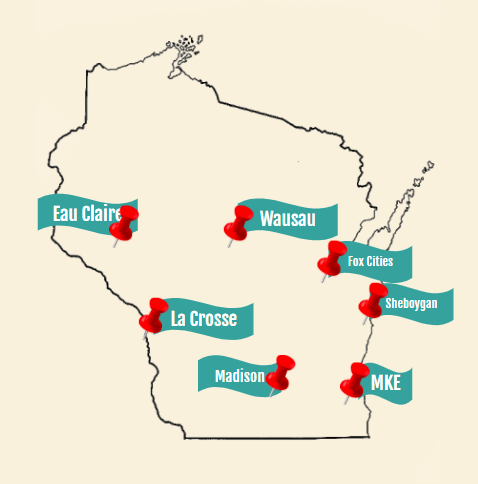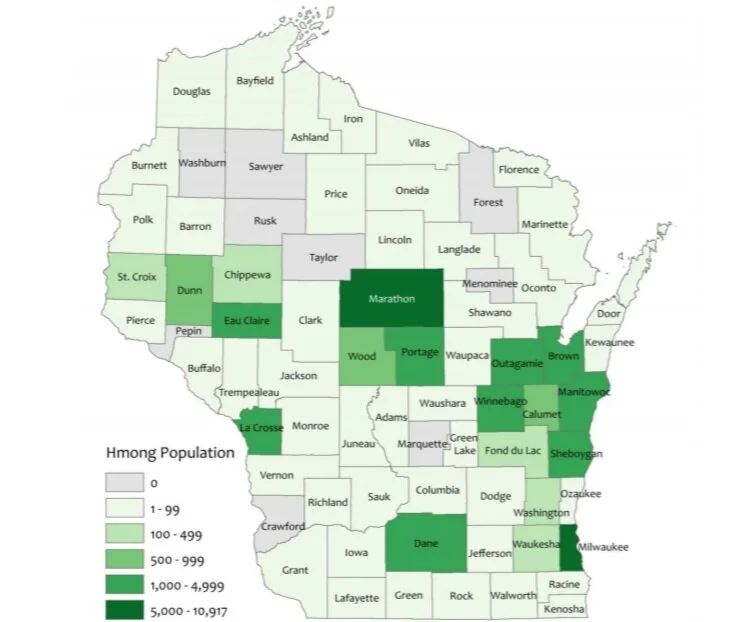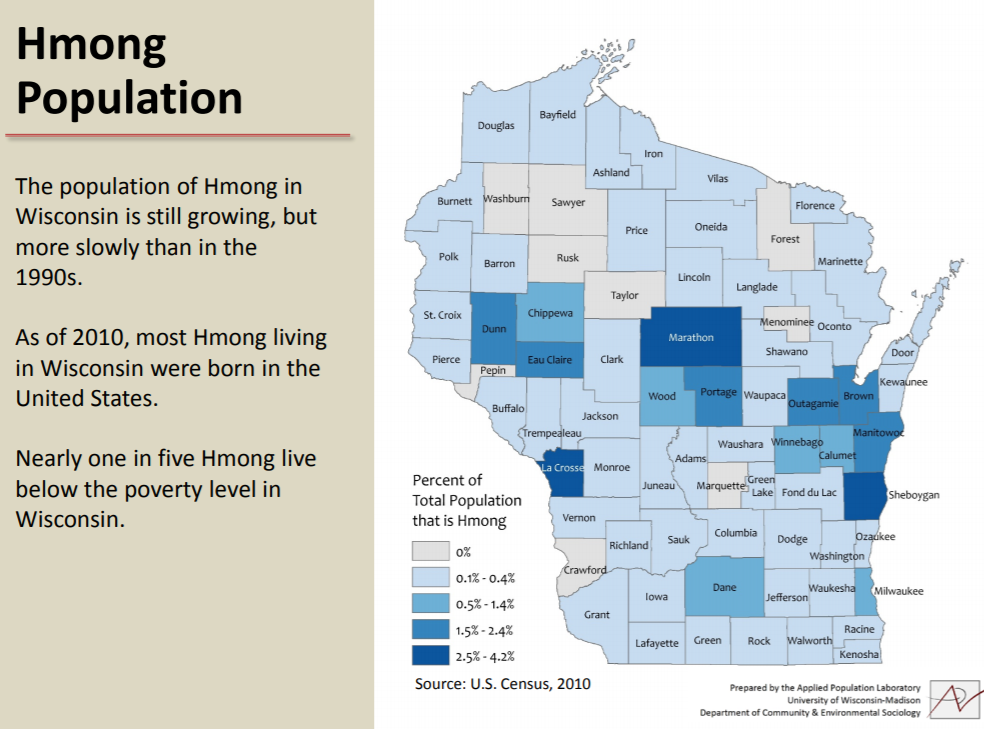
Hmong
Name
Hmong (also spelled Hmoob — the oo can be representative of the -ng sound, and the b helps indicate tone) describes the language as well as its speakers. Most native English speakers pronounce it as mong, without the initial “h” sound, but it isn’t like Spanish where the “h” sound is often not pronounced as all. Think of the sound you make when you say “hmmm” like you’re thinking about the answer to a question — the h sound is there, but it is very faint. There is a bit of controversy over what the term “Hmong” truly means, and if it includes the Hmong Der and Mong Leng people. As such, you may also see HMong or (H)mong written.
Size and Distribution
Note that most of this data comes from the 2010 census, so figures are different at present. However, the population is not growing at the rate it was before, so it is most likely not radically different from what is represented below. Unless otherwise listed, the information comes from:
https://washington.extension.wisc.edu/files/2010/07/hmong_chartbook_2010.pdf
https://cdn.apl.wisc.edu/publications/Wisconsin_Demographics_RERIC_2018.pdf
California, Minnesota, and Wisconsin are the three states with the largest concentration of Hmong people. California has a higher amount of people, while Minnesota and Wisconsin have a higher percent (concentration). The third most common language spoken in Wisconsin (after English and Spanish) is Hmong, and it is the only state that is true for.
The areas with the largest Hmong populations are shown at right. The Wausau/Eau Claire area is especially known for the presence of Hmong residents.
Though Milwaukee does not have the highest concentration, it has the largest Hmong population in the state.
Hmong residents make up the largest share of the Asian population in the state.
Even though 2-4% may not seem like much, it can still represent thousands of people. And, even if the concentration isn’t huge, the total population can be significant (such as in Milwaukee County).
Language and Education
It is hard to pinpoint a specific number of speakers, but it is estimated that there are a couple million speakers globally, with a couple hundred thousand living in the United States. http://www.hmongstudies.org/LemoineHSJ6.pdf
Green v.s. White Hmong
Listen to Mai Lee Vang’s interview to learn more!
Green and White are two dialects of Hmong that are considered to be mostly mutually intelligible, but it can sometimes be challenging to understand a speaker of the opposite dialect since differences go beyond pronunciation — actual words and grammar are different too. Hmong Green is considered more difficult/complex than Hmong White, so while a speaker of Hmong Green can often understand Hmong White, the opposite isn’t always true. Many believe the color distinction relates to the colors of a woman’s dress and traditional hats. Clothing can act as a “map," certain styles representing different regions and groups.
Green Hmong
It is also known as Mong Njua, Hmong Leng, or Hmong Lees. This is considered a softer variety, which many will say makes it more beautiful to listen to, but it is more difficult to get the pronunciation correct.
White Hmong
It is also known as Hmoob Dawb or Hmong Der. The RPA system (below) was created for this variety. It is generally considered to be more widely spoken and is more harsh in pronunciation. It is also considered easier to learn.
Structure and RPA Writing System
Hmong is a very complex language. It is tonal, meaning slight variations in pronunciation can completely change the meaning of a word. The last letter of a word is the tonal direction. Learn more about the tones here: http://www.hmongdictionary.com/tone%20chart.pdf
Hmong was standardized as a written language with the Hmong Romanized Popular Alphabet in the 1950s. This move was led by French missionaries, and though not everyone loves the final product, it has become standard in writing. They may have had a form of written language hundreds of years ago, but due to fear of persecution, its use was discontinued.
Hmong is a very indirect/circular language, so it can be quite difficult to translate directly to/from English. Additionally, there are many terms and specificities that aren’t covered in the Hmong language, and this shows up in medicine and education especially.
Language Preservation and Education Efforts
UW-Madison Hmong Studies Consortium
“The Hmong Language Resource Hub grew out of Hmong language, literacy, and culture teachers working together with youth, elders, artists, community members, and community organizations to create and share linguistically and culturally sustaining curriculum materials that connect school classrooms and the community. These units and materials, created by and for the Hmong community are free and openly available for anybody to access, share, and adapt.”
Click the image above to view another HAPA video!
(Direct Link: https://www.youtube.com/watch?v=DeKpuu5Xzoo)
HAPA — Hmong American Peace Academy
“In 2004, Hmong American Peace Academy, Ltd. opened as the first Hmong Charter School in Wisconsin to respond to the struggle of Milwaukee Hmong families in maintaining the bond with their children necessary to teach basic values, exert discipline and express their love for them. Education became the source of hope for maintaining the Hmong culture and embracing the best American values as well as providing opportunities for success as productive citizens.
The Milwaukee Hmong community worked together to bring HAPA to life and is committed to growing the school to serve every Hmong child in the community. Student enrollment has grown from 200 in 2004 to now serving over 1,800 students and is recognized as one of Milwaukee’s highest performing schools.”
Additional Educational Programs
In addition to HAPA, there are Hmong heritage programs, immersion programs, and language classes offered at other schools throughout the state. Check out the School Spotlight tab to learn more! https://www.myhapa.org/
History
Origin
The Hmong people do not have their own nation. They are an ethnic group that is said to have originated near the Yellow River in China. For many years, they suffered oppression as a minority group at the hands of the dominant Chinese. Later, around the 1800s, they moved south into Northern Vietnam, Laos, Thailand, India, and Myanmar (Burma). In these new areas, they led more simple lives as farmers and remained separate from the locals.
Image Source: https://keepinitrealevanston.wordpress.com/2012/07/10/554/
Clans
There are 18 Hmong clans. Clans are units larger than a family that share a similar last name. It is expected that you marry outside of your clan. Hmong society is patrilineal, meaning your ancestors are traced through your father.
Image Source: https://my-ecoach.com/project.php?id=17531&project_step=79441
Secret War
In ‘60s and ‘70s, the Hmong living in Laos were recruited by the CIA/France to fight against Vietnam, being promised protection no matter the outcome. These fighters were known as the Secret Army and tens of thousands didn’t make it out alive (in addition to the thousands of civilians who perished in the crossfires). Post war, the United States declined to provide aid and many were put into Thai refugee camps — and “put” doesn’t mean they received personal escorts to their new living arrangements. Many walked the long, treacherous journey.
Image source: https://www.wisconsinhistory.org/Records/Image/IM55932
Refugee Resettlement in the US
This process began around 1975, the first admitted mostly men high up in the army. In 1976, the first Hmong refugee was brought to Milwaukee. In 1980, following the passage of the Refugee Act/creation of the Office of Refugee Resettlement, the admission process became more streamlined and more were admitted.
There wasn’t much education for the surrounding communities when the Hmong began to arrive in Wisconsin (especially since it was a secret war), and distributing them across many counties put a strain on their clan system. Though maintaining a low profile allowed them to enjoy a relatively peaceful transition at first, descrimination became pervasive in the following years. Wisconsin was seen as an attractive settlement option due to the education and employment opportunities and the availability of sponsors. These church sponsors often didn’t know much about the new arrivals and would often bring Vietnamese interpreters. There are a lot of foundational skills to figure out, even things as simple as how to work kitchen appliances, that become very difficult to walk someone through when you share no common language.
Mutual Assistance Associations proved to be vital for maintaining connections and supporting one another.
Image source: https://www.mnhs.org/hmong/hmong-timeline
Note that the mention of Myanmar/Burma on these graphs refers primarily to Rohingya refugees, even though there was some Hmong presence in the nation. It is difficult to graph Hmong refugees, as they don’t nicely fit under one country’s label, but Laos can be equated to Hmong for these purposes.
Early 2000s
In 2003-2004, the United States allowed 15,000 more Hmong to come to the U.S. so the refugee camps in Thailand could be closed. 3,300 were brought to Wisconsin.
Tensions continued, and one particularly challenging moment was when the Hmong community got word of racist remarks on the part of one UW-Madison professor. In an effort to not bring up any past pain, I am going to decline to link the article here.
As individuals lost refugee status (and support), but hadn’t gotten to a place where they are entirely independent, many struggled to get by. Others, though, found avenues to greater financial stability by selling crafts or agricultural products at farmers’ markets and through other local mechanisms. There was a divide between whether they should sell goods that were familiar to them, but “exotic” to many who had lived in the US for a while (and as a result wouldn’t sell well), or pick the crops that would yield the greatest economic return. Most chose the latter.
Misunderstandings were discriminatory at best, deadly at worse, some incidents gaining national recognition. The community nor the teachers in schools were educated on practices and traditions of the Hmong people and a lot of avoidable suffering occurred.
La Crosse created a Hmong Culture and Community Center.
Image source: https://www.wisconsinhistory.org/Records/Image/IM110177
Today
There are about 50,000 Hmong living in Wisconsin.
In 2014, UW-Madison welcomed “UW-Madison's first professor in Hmong American Studies -- the only tenure-track faculty in his field in the world.” Today, there are additional Hmong professors at UW-Madison and other universities across the state, as well as growing educational and extracurricular opportunities for Hmong students and families in Wisconsin.
Learn more about a new project at UW-Madison with the goal to “investigate mechanisms that produce higher education inequalities for Hmong American students and engage in what we call counter-invisibility work. This involves reporting findings to support advocacy for specific policy changes that address factors producing inequalities that can be shared with students, educators, community members and administrators.”
The role of women have started to change, which on the surface level may seem like a positive thing, but much of this was spurred by men having difficulty processing all the PTSD from the war.
However, more presently, there has been direct, unacceptable bias and racism directed at the Asian community both here in Wisconsin and nationally. Learn more about how students are responding in my interview with Mayder Lor. As she says, it is horrible that students are being put in a position where they feel like they need to speak up, but the work they are doing is incredible.
Image source: https://www.flickr.com/photos/lesterpubliclibrary/5002884793
The 2006-2010 data was most likely impacted by the recession, but it is still clear that more Hmong Persons are joining the labor force.
Though the decrease in poverty is really encouraging, the percent in poverty is still almost double the overall Wisconsin rate (https://www.irp.wisc.edu/resources/who-is-poor-in-wisconsin/).
Resources
Sources and further reading:
Demystify the Complex Hmong Language
Wausau Area Mutual Association
Encyclopedia of Miliwaukee — Hmong
To Be Both Midwestern and Hmong
5 Things I Bet You Didn’t Know About Hmong in Marathon County
Elementary Hmong club focuses on culture
Critics Of Wausau Schools Plan Say Hmong Community Was Excluded
School Spotlight: Hmong Literacy Club connects children with family members
HMoob American Studies Committee UW-Madison
Brand New Badger: Daughter of Hmong immigrants part of national push for more women in technology
University of Wisconsin – Extension Hmong Educational Needs Assessment Project
Hmong in Wisconsin — Historical Society
Hmong Education Project Lincoln MS
Bilingual Hmong-English Program Information
Introduction to White Hmong Language
Hmong Still Struggle for Acceptance in Wisconsin Communities
For Hmong Speakers, Keeping Wisconsin's Third Most Commonly Spoken Language Alive Is Essential
A Brief History of the Hmong Immigrant Community in Wisconsin
The Cultural Landscape of the Hmong in Eau Claire, Wisconsin
‘I almost got killed’: the Hmong refugees who call the US home
Bill would bring Hmong history into Wisconsin classrooms
WPT EDUCATION BRINGS HMONG HISTORY TO WISCONSIN CLASSROOMS
Special day teaches students about Hmong culture
Wisconsin students celebrate Hmong language, culture
Book: Green Card Youth Voices: Immigration Stories from Madison and Milwaukee High Schools
Book: Wisconsin Talk
Heritage Languages In Wisconsin
Wisconsin Refugee Resettlement Drastically Slows
Refugee Resettlement In Wisconsin, By The Numbers
Hmong in Wisconsin: A Statistical Overview
The Hmong Community Marks 40 Years In Wisconsin
HMONG LANGUAGE AND CULTURAL ENRICHMENT PROGRAM


















